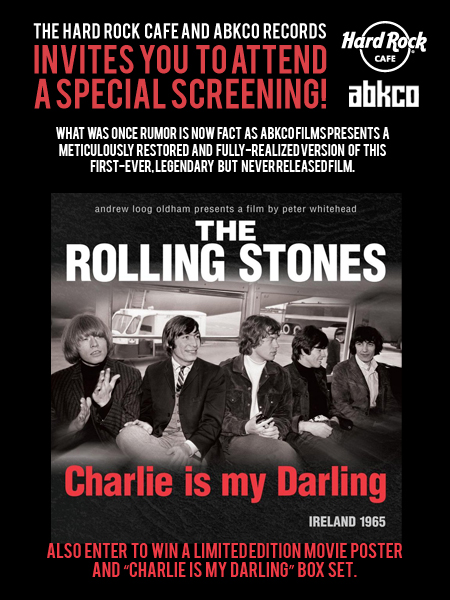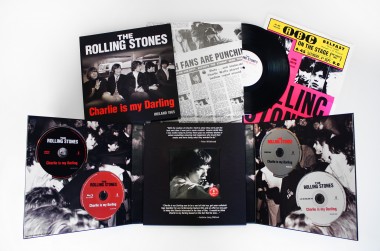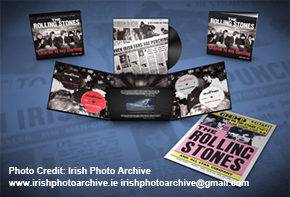ABKCO Films and Hard Rock Cafes around the U.S. are celebrating the release of
The Rolling Stones Charlie is my Darling – Ireland 1965 this November!
Head to Hard Rock to watch the film and enter to win some great Charlie is my Darling prizes!
See below for a list of participating locations dates and times. Hope to see you there!

SCHEDULE
ATLANTA, GA
Monday, November 12th at 7 p.m.
Hard Rock Cafe Atlanta
215 Peachtree St. NE
P: 404-688-7625
BOSTON, MA
Tuesday, November 13th at 7 p.m.
Hard Rock Cafe Boston
22-24 Clinton St.
617-424-7625
CHICAGO, IL
Wednesday, November 14th at 8 p.m.
Hard Rock Cafe Chicago
63 West Ontario
P: 312-943-2252
HOLLYWOOD, CA
Wednesday, November 14th at 8 p.m.
Hard Rock Cafe Hollywood
6801 Hollywood Blvd. #105
P: 323-464-7625
LAS VEGAS, NV
Thursday, November 15th at 7 p.m.
Hard Rock Cafe Las Vegas
3771 S. Las Vegas Blvd
702-733-7625
SAN ANTONIO, TX
Sunday, November 18th at 7 p.m.
Hard Rock Cafe San Antonio
111 W. Crockett St.
P: 210-224-7625
SAN FRANCISCO, CA
Tuesday, November 13th at 5:30 p.m.
Hard Rock Cafe San Francisco
39 Pier #256
P: 415-956-2013
WASHINGTON, DC
Monday, November 12th at 7 p.m.
Hard Rock Cafe Washington, DC
610 10th Street NW, Suite 200
P: 202-737-7625
Photo Credit: Irish Photo Archive
ABKCO Films’ acclaimed Rolling Stones documentary The Rolling Stones Charlie Is My Darling–Ireland 1965 came out yesterday in Super Deluxe box set, Blu-ray and DVD configurations.
Additionally, the film, which shows never-before-seen footage of the Stones’ first filmed concert event, is set to premiere Nov. 10 in theaters and on DIRECTV’s Audience Network’s Something To Talk About series of socially and culturally relevant documentaries.
Charlie Is My Darling–Ireland 1965 was originally directed by English filmmaker Peter Whitehead, who later directed several music videos for the Stones, and produced by the band’s first manager and producer Andrew Loog Oldham. It was shot during a weekend tour of Ireland just weeks after “(I Can’t Get No) Satisfaction” hit No. 1 on the charts.
But Whitehead’s 35-minute cinema verite version of the film, while legendary, was never released officially. The new ABKCO release, at 65 minutes, is substantially longer and fully realized, with meticulously restored footage. Produced by the Grammy-winning team of producer Robin Klein and director Mick Gochanour (Best Long Form Video for Sam Cooke: Legend), it has new concert footage of performances including “The Last Time,” “Time Is On My Side” and the first-ever concert performance of “(I Can’t Get No) Satisfaction”—all professionally filmed and full of frenzied fan reactions.
Charlie Is My Darling also presents intimate, behind-the-scenes material depicting the young group’s life on the road, including impromptu interviews, songwriting and singing sessions.
All three ABKCO Charlie Is My Darling packagings contain the original Whitehead version of the film, a 50-minute version by Oldham that was first seen in the 1980s, and the new Klein-Gochanour production. The Super Deluxe box set includes both DVD and Blu-ray discs, plus unseen additional performance and other footage shot in Dublin and Belfast in September, 1965.
Also contained in the Super Deluxe set are two CDs: One is the film’s soundtrack and the other a compilation of 13 live recordings the band made during its 1965 U.K. tour. A 10-inch vinyl record of the live material is also included, along with a replica poster promoting the Belfast show; the box also has a 42-page hardcover book including key artwork and photos, vintage press reprints and contemporary essays from Rolling Stone’s David Fricke and Academy Award-winning Irish singer-songwriter/actor Glen Hansard.
Oldham had wanted Whitehead to travel with the group and film them.
“The Beatles had done Hard Days Night,” says Klein. “Everybody was looking toward film, so Andrew hired Peter to see what the Stones would be like around a camera and get them used to the idea—‘get their celluloid legs,’ in Andrewspeak. So Peter was there for everything: when they were writing songs, on the train and public transportation. ‘Satisfaction’ was No. 1, but they were in Ireland, where people kind of knew who they were, but not really.”
The Stones did four 35-minute shows in two nights in Ireland, before returning to London and then heading to Los Angeles to record “Get Off Of My Cloud.” According to Klein, there was no documentation relating to the scenes in Whitehead’s original Charlie version. ABKCO, she says, also discovered last year that much of the film’s negatives hadn’t been exposed.
“The film was not supposed to come out, but Peter got angry at Andrew and showed it at a festival,” continues Klein. “Andrew didn’t want to put it out, as he and the Stones were more concerned with touring and songwriting. So it was shelved, like the Rock And Roll Circus [the legendary The Rolling Stones Rock And Roll Circus program, starring the Stones and guests including John Lennon and Eric Clapton, which ABKCO eventually released on DVD].”
“But parts of it emerged on [‘60s TV shows] Shindig! and Top Of The Pops when the Stones were unable to perform live because they were touring,” Klein adds. “Andrew cut it up as music video and farmed it out, and that’s how it got seen—if it got seen.”
She stresses, however, that the new ABKCO version of Charlie Is My Darling is not a “restoration project” as such.
“It gets confusing because we kept the title, and the footage was shot for that project,” explains Klein. “But as we all know, that project was not meant to come out.”
ABKCO, whose late founder Allen Klein had managed the Stones, had access to Whitehead’s material, but his version wasn’t long enough to put out, and an early attempt to expand it for DVD with extra material was unsatisfactory.
Then last year Oldham suggested to go back to it “as a restoration piece,” notes Klein, “but it was a mess—and we didn’t have audio.”
Still, Gochanour was determined, Klein says, “so last summer we sat there and meticulously—and painfully!—organized everything into bins, by song, name, color, even Mick’s coat, which was black one night, white another.”
Pertaining to songs, Klein says they had to read lips at times to identify the song footage; luckily, “we had the set lists!” Gochanour and editor Nathan Punwar “had enough [camera] coverage to cover a song,” meaning there was usually enough existing footage available to construct a complete song performance on video, even though it was shot mostly with one camera, with an eight-minute film reel capacity.
“There were 30,000 to 40,000 frames per reel, and it took us two days to scan one reel,” she says, speaking of the painstaking process of converting Whitehead’s film elements, which were in London, to high-definition Blu-ray video media. There were 35 cans of footage, totaling six hours of film altogether.
“Everything was shot in ’65, so it was breaking and tearing and was chemically stained and faded and scratched–literally dumped on the cutting room floor,” says Klein. “After scanning everything for three months, we started editing with all this extra footage–not just performances but extra scenes and interviews and voice-overs. So we actually deconstructed Peter’s version.”
Klein describes the rest of the process as strictly “analog” in arranging index cards on a wall in coming up with a new storyboard consisting of 90,000 frames of hand-restored original footage.
“The footage was restored, but it’s a new story about the Stones on the road and people in the audience seeing them live,” she says. “Up until then the only live footage of the Stones was TV footage, with rather subdued audiences—except on Ready Steady Go!, where people were encouraged to dance. Here the audiences are going crazy and rioting. Other than having the same title—which has lived on in ‘Bootleg Land’–it’s a very different film than Peter’s version.”
Klein recalls her joke at the dawn of the VHS home video configuration, that the software releases that launched it were porn titles and Charlie Is My Darling.
“It’s been out forever in all the different manifestations and cuts, but they never had the restored concert audio and picture before—and synched together,” she says. “Nathan spent hour after hour after hour reading lips, counting beats and watching notes played on guitars to synch up with the music. And besides the concert performances, there are the great scenes of them singing Elvis songs and Beatles songs, and writing ‘Sittin’ On A Fence.’ It’s incredible.”
And where Whitehead was interested in “the dichotomy between the exterior person and the interior person–the person behind the mask,” Gochanour’s take concerns “being on tour–and the effect of fame.”
And the new version of Charlie Is My Darling also depicts a cultural revolution, points out Klein.
“Listen to Mick Jagger—then a 22-year-old—talking about the difference between songwriting in 1965 and songwriting 10 years earlier,” she says. “Then it was just pop songs about love, as opposed to real things Mick was writing about–like getting up and going to work and feeling really screwed up about everything at 22.”
Then there’s Brian Jones.
“Everyone quotes his line, ‘The future as a Rolling Stone is very uncertain,’ but he talks about it, and is very ambivalent about the future—and he’d be dead in four years! And Charlie [Watts] talks about how he really wants to be home and playing jazz and being with his wife, and Bill [Wyman] says how he’s not really a musician but just a player in a band—and that there’s got to be an easier way of making a living.”
“It’s pretty wild!” Klein concludes.
By Jim Bessman
@JimBessman
Click Here For More




















